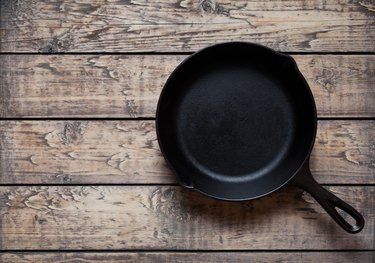
Cast iron pots and pans are a treasure for many home chefs. The heavy and reliable cookware is found in kitchens around the world. But when the self basting Dutch oven becomes caked in sticky cooked-on gunk or the self basting lid is splattered with globs of oily sauce that has hardened, it may be hard to know how to clean the favored item without damaging it.
The self basting in the description of a cast iron refers to a lid that is specially designed for the pot. Typically, it has spikes or ridges on the inside of the lid that catch steam as it builds and rises in the pot during cooking. The steam is then condensed into water droplets, and the water slides down the spikes or forms along the base of the ridges that hover over the food. The water slowly drips onto the food, creating a moist environment.
Video of the Day
Video of the Day
How to Best Use a Self-Basting Cast Iron Pot
A self basting cast iron pot works well for many foods, but can also be counterproductive if you are looking to create a crisp crust or perfect sear. Stews, braised meats that fall off the bone, creamy soups or briny broths all work very well in the self basting cast iron pot.
Corn bread, pies, biscuits or other flour-based baked goods will get soggy and not get crispy around the edges or top when the lid is placed on the pot during cooking. Generally, baked items don't require the cast iron self basting lid to be used.
If, for baking, you need to use the pot with the lid on, then you can still get a crisp crust by wrapping a towel around the lid. This will catch any steam that attempts to attach to the lid and prevent the moisture from finding its way onto the food.
Roasters with Self Basting Lids
Aside from cast iron pans, individual roasters can have self basting lids that can be a great help in roasting whole chickens, beef roasts and pork loins.
A large capacity countertop oven, such as an Oster roaster oven with self-basting lid, can increase the space you have to complete elaborate holiday dinners. They are also ideal for dorm rooms and campers to increase the types of healthy, homecooked meals you are able to create.
The bumps and shape of the lid of the countertop roaster matter. These grooves or dimples on the rounded lid are designed to collect and direct moisture to the meats and vegetables in the body of the roaster. This helps to keep the meat moist and juicy, thoroughly cooking dense vegetables without drying out the prepared ingredients.
Cleaning and Care for Self Basting Cast Iron Cookware
A self basting Dutch oven, skillet or pot requires the same care as other cast iron cookware. Gently clean it with water and a sponge, then place it on the stove on low heat to dry.
Don't leave a recently cleaned pot on the heat for too long or it can cause problems with the natural non-stick surface that has been seasoned into the cast iron pan.
Cast Iron Skillet Lid with Spikes
The cast iron skillet lid with spikes or ridges can seem difficult to clean at first glance. The dimples and bumps need a good wash, and a spiked cast iron lid may need a little more care.
The spikes work best when clean from bits of food or hardened sauces. Take a soft, dry cloth immediately after cooking is complete and run it along the individual spikes to remove moisture and any splatters from the recipe.